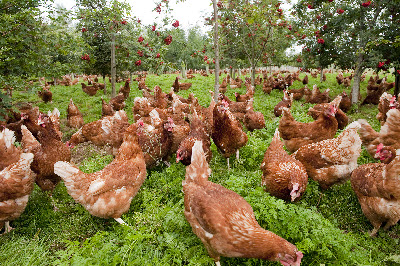



Laying Hens go Undercover to Improve Production
Planting trees on the range for outdoor hens brought both economic and welfare benefits, according to new research from the UK.This work was carried out by McDonalds sustainable egg supply working group which was set up to address welfare and other sustainability issues in laying hens, according to Bright and Joret in their paper published in Veterinary Record.
Background
In 2007, McDonalds’ egg suppliers, The Lakes Free Range Egg Company and Noble Foods Ltd, (all free–range) were required to plant a minimum of five per cent of the range with trees (if not already planted).
It is well established that tree cover provision improves the welfare of free–range laying hens. However, producers also noticed that since tree planting, there there was less egg seconds and lower bird mortality. Egg seconds due to poor shell quality are a significant cost to the egg industry – in the UK, a seconds egg is worth approximately 30 per cent that of a Grade A egg – and bird mortality obviously represents an economic cost to producers since birds that die during lay have already consumed feed (and other) resources, and fewer birds per house produce fewer eggs. Demonstration of an economic benefit of tree cover provision would be an added incentive for free range egg producers to invest in tree planting.
In this study, the authors, Bright and Joret, investigated whether there was a difference in both packing station egg seconds and mortality in matched free–range laying flocks, with and without tree cover on the range. Thirty–three free–range flocks with trees were compared with 33 flocks without trees; the flocks were matched for strain, flock size, week of placement at the laying farm and percentage tree cover.
This ‘matched pair’ analysis eliminates much of the variation between flocks that might be expected due to, for example, different strains and flocks sizes.

Results
In flocks with tree cover, there were significantly less 45–week–and–over packing station egg seconds (4.8 per cent) than flocks without tree cover (5.9 per cent). There was also lower mortality in flocks with tree cover (10.6 per cent) than flocks without tree cover (13.8 per cent), although this was not quite statistically significant.
In the UK, a second egg is worth approximately one–third that of a Class A egg. If tree cover provision results in an approximately one per cent decrease in packing station seconds and a one per cent decrease in farm seconds (since the underlying reasons for both seconds are similar), then in a 10,000–bird flock (assuming 24 dozen eggs per bird), approximately 4,800 eggs would move to Class A from seconds.
By demonstrating an economic as well as a welfare benefit to planting trees on the laying hen range, McDonalds and their suppliers hope to incentivise tree planting by other egg producers. There may also be additional benefits to tree planting such as improved biodiversity and carbon sequestration although these are yet to be investigated.
Reference
Bright A. and A.D. Joret. 2012. Laying hens go undercover to improve production. Veterinary Record, 170:228. doi: 10.1136/vr.100503
Further Reading
| - | You can view the full report by clicking here. |
April 2012








